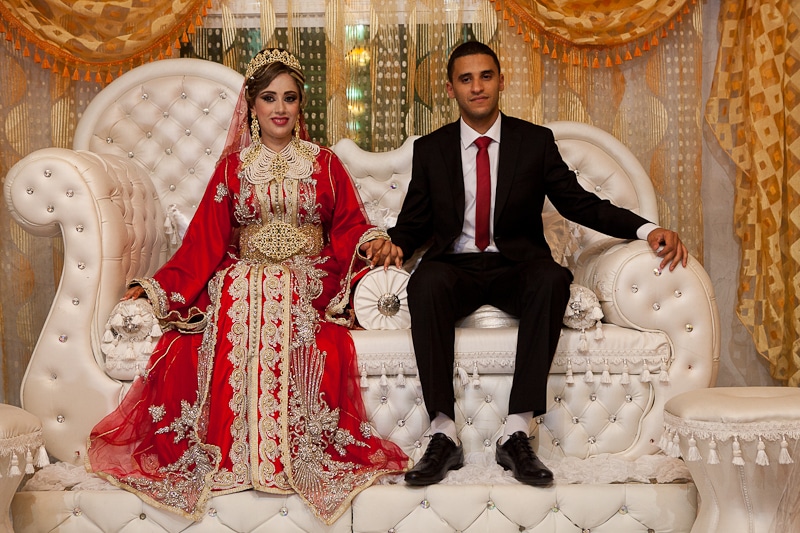6. The offering ritual
Between the engagement and the wedding, it is common for the future husband to shower the lucky bride with gifts and offerings called Hdiyya. These can be symbolic: milk, sugar, dates, Koran, henna, flowers… or material: silky fabrics, caftans, handbags, jewelry, perfumes, shoes. The contents of the Hdiyya vary according to the financial means of the groom’s family. Carefully arranged in large trays covered with conical lids called taifors, the gifts are given to the bride during a ceremony called the Hdiyya ceremony which is preceded by a musical procession. It should be noted that these gifts are often assimilated to the bride’s dowry.
7. The dowry
An essential condition for the validity of the marriage, the dowry (sadaq) is a sum of money or goods constituted by the suitor for the benefit of his wife. Contractualized by the adouls during the ceremony of the act, the dowry is governed by the family code of Morocco which draws its inspiration from the Holy Koran and the Sunna. Thus, to consolidate “the desire to create a home and to live in the bonds of mutual affection”, the future groom will offer his wife a large sum of money, livestock, a piece of furniture or even an apartment (it is rarer)… If the legal basis of the dowry consists in its moral and symbolic value (Article 26 of the Family Code), it is to be noted that it is more often the material value that prevails. To the point of being perceived as an economic burden by some families who do not hesitate to put the dowry on the table of the marriage negotiations. Many couples, judging the dowry to be humiliating, opt for the contribution of a symbolic dirham!
8. The Hammam ritual – EVJF Act I
In Morocco, the Bachelorette party as we know it in our country is often replaced by a number of “before” ceremonies. 100% girly, the passage to the hammam is an ancient ritual of purification and relaxation that often precedes the D-day.
9. The henna ritual – EVJF Act II
After the hammam ceremony, it’s time for the henna ceremony that takes place the day before the big day, or even during the afternoon before the big party. A hennaya (henna tattooist) tattoos the hands and/or feet of the bride, pulsating with the youyous and the traditional dances and songs of the women (friends, cousins, aunts, mothers, etc.) who follow one another. The whole thing takes place in a good-natured atmosphere (no dares, challenges or chippendales in the Moroccan EVJF…). The guests who wish to be tattooed do not cut the beautiful stylized and geometrical arabesques, symbols of happiness and prosperity for the future life.
The variations around the Moroccan wedding. Of course, the Made In Morocco wedding varies according to the regions, the families but also the social origin of the families. In the countryside, it is not uncommon for the preparation of the wedding to mobilize the entire douar (village) and last for several days. In some regions of the Rif, the mix is not de rigueur: women on one side, men on the other. The atmosphere is sometimes festive (the guests and the bride and groom dance), sometimes wise (the guests discuss and observe each other).
In the posh districts of the big cities, the wedding can sometimes take on the air of an Open Bar with DJ and champagne galore… or even turn into a “éclatade” with 3200 round tables at the edge of the pleasure pool or float a Welcome in “niniphars” (the floating flowers of Mrs. Tazi – Poke Gad ElMaleh)… You have understood, in Morocco (as elsewhere), there are 1000 ways – or more exactly 1001 ways – to celebrate the wedding!
10. The beauty salon
The bride must be the most beautiful to go dancing (even if she won’t dance… or not much!). To do this, she must go to the beauty salon. Hairstyle, makeup, manicure, pedicure, waxing, eyelash extensions, facials, nail polish… We don’t skimp on the total makeover… even if we have to force the dose (sometimes) a bit!
11. Dress code of the guests
The guests start to flock to the wedding place around 8 or 9 pm… The bride is not there yet (she rarely appears before 11 pm!). However the visual and sound show has already begun. Caftans, takchitas and silky finery parade to the rhythm of traditional songs propelled by the orchestra. The colors are everywhere: fuchia, gold, pink, red, blue, green, orange to the point that we wonder if the bride will be able to compete. It’s time to greet, to meet, to hug and fruit juices, tea, snacks and dried fruits are invited on the tables.


